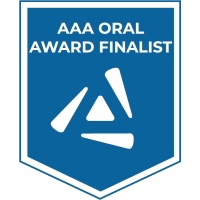Back
ANATOMY
Neuroscience
368.3 - Human Fetal Brain Magnetic Resonance Imaging (MRI) Tells Future Emergence of Autism Spectrum Disorders
Tuesday, April 5, 2022
9:30 AM – 9:45 AM
Room: 108 A - Pennsylvania Convention Center
Introduction: C.J. Herrick Award in Neuroanatomy Lecture featuring 2022 Early-Career Investigator Award Recipient Michael Yartsev
View image here
Alpen Ortug (Harvard Medical School, Harvard Medical School, Harvard Medical School, Harvard Medical School), Yurui Guo (Boston Childrens Hospital, Boston Childrens Hospital), Henry Arthur Feldman (Boston Childrens Hospital, Boston Childrens Hospital), Yangming Ou (Boston Childrens Hospital, Boston Childrens Hospital), Harrison Dieuveuil (Boston Childrens Hospital, Boston Childrens Hospital), Nicole Tara Baumer (Boston Childrens Hospital, Boston Childrens Hospital), Susan Kaminski Faja (Boston Childrens Hospital, Boston Childrens Hospital), Emi Takahashi (Harvard Medical School, Harvard Medical School, Harvard Medical School, Harvard Medical School)
-
Alpen Ortug
Presenting Author
Harvard Medical School, Harvard Medical School, Harvard Medical School, Harvard Medical School
Presenting Author(s)
Autism spectrum disorder (ASD) is a complex neurodevelopmental disorder which can result from a range of observed symptoms pertaining to social, emotional, and cognitive processing difficulties especially regarding communication of their own feelings, opinions, and thoughts with others. Although a diagnosis received by 1 in 68 children in the United States, a cause for autism is still unknown. Both genetic and environmental factors during prenatal and postnatal development are believed to account for the emergence of ASD. It is known that early treatment improves language and cognitive abilities later. However, currently, the earliest diagnosis of ASD can be made only around 18 months of age. It is critical to be aware of an altered initial brain anatomy in ASD for better predicting what aspects of brain function will likely preferentially and precociously deteriorate, which would allow for potentially earlier/better prevention and treatment. We hypothesized that prospective ASD patients will show region-specific abnormalities in developmental stages. We have used retrospective clinical brain MRI of the fetuses who were diagnosed as ASD in later age to obtain earliest MRI-based regional volumetric biomarkers. Thirty-nine fetuses (mean age 24.87 ± 5.05 gestational week [GW]) were included in this study (9 prospective ASD patients, 20 neurotypical controls, 6 non-ASD controls with neurological comorbidities observed in the prospective ASD patients, and 4 non-ASD controls with non-neurological comorbidities observed in the prospective ASD patients. After preprocessing, the images were segmented automatically with an atlas-based automated anatomical labeling method. A set of three-factor ANOVA was performed for lobar and regional comparisons of the segmented brain regions. The insula/insular lobe showed statistically significantly larger volume in ASD than that in all three control groups in the lobar comparison. In the regional comparison, the ASD group had statistically significantly larger amygdala, hippocampal commissure, and insula compared to the non-ASD controls with neurological and non-neurological comorbidities. Our results suggest that an increased volume of the insula/insular lobe may be a strong prenatal MRI biomarker that could predict the emergence of ASD later in life. The larger amygdala and hippocampal commissure could be additional biomarkers for identifying such prospective ASD patients.
Keywords: autism spectrum disorder, fetal MRI, brain segmentation
Support or Funding Information
This project was supported by NIH R21MH118739, R21HD098606, and R01NS109475 to ET.

Examples of regional brain segmentation of a healthy male fetus at 30 gestational weeks (GW). a: Axial (left), sagittal (middle), and coronal (right) views of T2- weighted MRI images. b: Axial (left), sagittal (middle), and coronal (right) views of segmented brain regions. c: Three-dimensional lateral views (left and middle) and a ventral view (right) of segmented cortical regions. (A: anterior, P: posterior, R: right L: left)
Keywords: autism spectrum disorder, fetal MRI, brain segmentation
Support or Funding Information
This project was supported by NIH R21MH118739, R21HD098606, and R01NS109475 to ET.

Examples of regional brain segmentation of a healthy male fetus at 30 gestational weeks (GW). a: Axial (left), sagittal (middle), and coronal (right) views of T2- weighted MRI images. b: Axial (left), sagittal (middle), and coronal (right) views of segmented brain regions. c: Three-dimensional lateral views (left and middle) and a ventral view (right) of segmented cortical regions. (A: anterior, P: posterior, R: right L: left)

